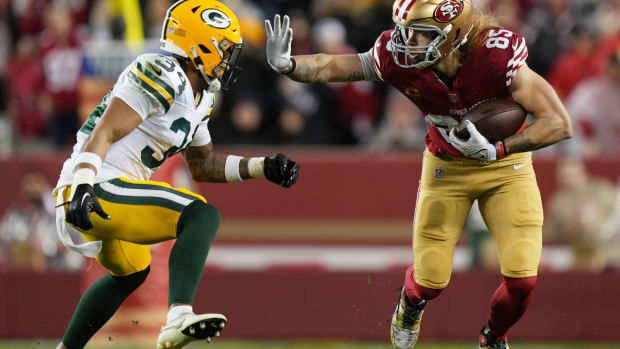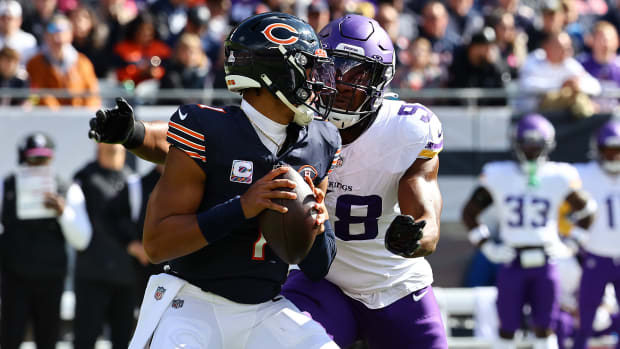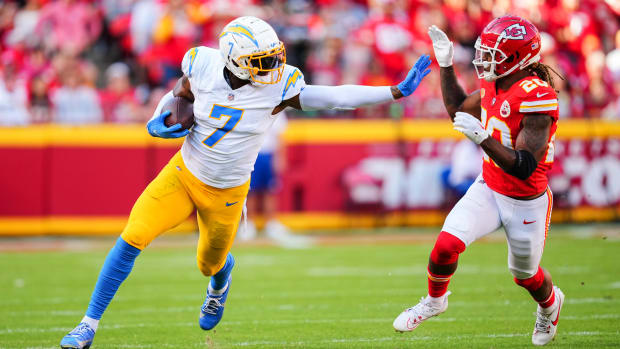Red Zone Control Defines a Changed Bears Defense
Bears defensive players talked extensively about dominating opponents two years ago and then did.
The message changed as personnel and coaching changed. They're adapting.
Events have caused the Bears to talk about being a bend-but-don't-break defense. In some football circles, this is akin to capitulation. The 1985 Bears would have vomitted at the thought.
These Bears make it work.
"We would like to keep them from driving, but us standing up in the red zone just letting everybody know we might bend but we won't break, that's the type of mentality that keeps us going," safety Eddie Jackson said.
Their scorched earth mentality works. The Bears still have defensive dominance, but it's limited to inside the 20-yard line.
With a 36.8% touchdown percentage allowed inside the red zone, the Bears are by far and away No. 1. Arizona is next best at 42.86%. There are only four defenses in the league below 50%.
"It's something that, you know, during the course of a game, you don't have control of everything, especially when you are playing players like Tom Brady, right?" defensive end Akiem Hicks said. "But your job is to knuckle up when you need to.
"Like I've said in previous interviews, when your back is against the wall, how hard are you going to fight? And you see that when we step into the red zone. There is no quit in our defense. There is no give up."
The goal is giving up field goals instead of touchdowns. The Bears have allowed 19 red-zone incursions, and only nine teams have allowed more. They've given up only seven touchdowns in the red zone.
"I think we just, the guys feel comfortable where we're at, from a call standpoint," defensive coordinator Chuck Pagano said. "Based on what we're playing, and our different personnel packages, they feel comfortable with the things that we're playing.
"They trust 'em. They trust each other. The communication has been really well. And we've been able to get out of some situations and forced some field goals, fortunately."
There is no question teams have consistently moved the ball against them. League highs of 10 field goals allowed and 75 third downs faced suggest this much. They are giving up 6.08 yards on every first-down play, the league's ninth highest average.
These all say they allow too many drives.
"We play football and during the course of a football game, you are going to lose a rep or two," Hicks said. "Your job is to come back and play to the best of your ability having a short memory is a term that has become cliché, right, in our league but you gotta be able to have that, you gotta be able to say, 'Hey, we didn't get the success that we wanted on first down, matter of fact they just got another first down, what are we going to do next?'
"As far as the terminology, bend-but-don't break or give up a lot of points, whatever it is, we are going to play football and that is what we believe in."
In this regard Sunday's game is a challenge because Carolina is a ball-control team.
This dominant Bears red-zone defense is all part of a team-wide emphasis on winning at situational football.
Their ability to stop third downs is part, as well. While the Bears faced more third-down plays than any team in the league (75) and have given up the ninth highest average gains on first-down plays, they also are No. 2 in stopping third-down conversions at 33.3%.
"Our goal is to be better than we were in previous years," Hicks said. "This year and years to come, we want to be a high-level, elite team that when teams come to our stadium or we come to theirs, there is a feeling in the air, there is a sense of we are about to play at our highest level and they're going to have to compete with us.
"So I think it's a culture that has been growing and changing since I've been here in 2016. I think we're seeing and have seen some growth to a team that should be respected and that should be feared."
They obvious difference between a dominant 2018 defense and one dominant mainly in the red zone is their problem stopping the run. They still get the tackles for loss like when they were No. 1 against the run in 2018. However, they get gashed for more long runs than in the past, and much has to do with losing nose tackle Eddie Goldman to an opt-out.
If they can improve on their ranking of 16th against the run and start doing better than the five turnovers they've forced, then this metamorphosis into a bend-but-don't-break defense might revert to complete dominance like in 2018.
It would leave very little for opposing offenses because this defense, despite its weaknesses, has given up the ninth-fewest TD runs and the fewest number of TD passes in the NFL.
"We hold ourselves to a very high standard on the defensive side of the ball," Jackson said. "Just got to continue to get better."
Twitter: BearDigest@BearsOnMaven




